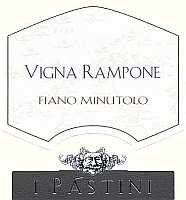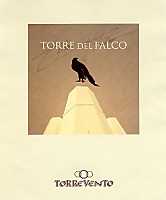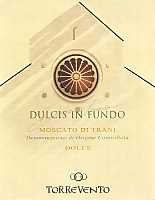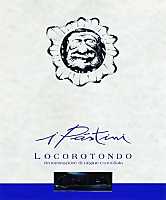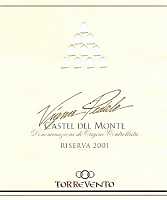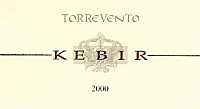|
Among the most famous monuments of the Apulia region - as well as of the world -
there is the suggestive “Castel del Monte”, the renowned building with
octagonal base which Frederich II of Swabia built in 1220 as his hunting lodge
and today recognized as a worldwide heritage from UNESCO. The celebrity and the
historical importance of this beautiful building is such that its image has been
used in the back side of the one cent Euro coin issued by the Italian Republic.
In Apulia, Castel del Monte does not only mean the suggestive building, in the
world of enology is also synonym of wine and - in particular - it is an area of
Denomination of Controlled Origin (DOC) of the region representing the “heel”
of Italy. The octagonal shape of the famous monument was also used for the
trademark of Torrevento winery located at Corato, in the province of Bari and
not distant from the suggestive building.
|
 | |
| Pasquale Carparelli and Francesco
Liantonio, wine maker and chairman of Torrevento | |
|
In the eighteenth century, not far from the renowned monument - exactly at
“Torrevento” place - was built one of the most beautiful monasteries in stone
of all North-Western Murgia. In 1949, when the monastery was not used anymore as
a place of cult, it was purchased, together with the estate, by brothers
Liantonio. In this place they established the family wine business and later it
was called like the place in which is located Torrevento winery. The thick walls
of the monastery - with a thickness of 1.5 meters (about 5 feet) - host the large
cellar built in the rock of the ancient undergrounds of the monastery: here, at
about 8 meters deep (26 feet) and in optimal conditions, are being aged
Torrevento's wines. The building underwent important restoration works in order
to allow a proper expansion as well as the introduction of new technologies,
according to a precise plan of development and in the full respect of the
original structure, as well as of the territory of Murgia and of the views of
Castel del Monte area in which it is located.
Recently at Torrevento they restored the ancient stable therefore transforming
it into a welcoming wine tasting hall with stone walls, used to welcome
tourists, clients and wine lovers. Torrevento is particularly involved in the
production of wines with typical grapes of the Apulian enology. The mainly hilly
nature of the Bari's northern Murgia - area in which are located the vineyards
of the winery - as well as a favorable microclimate, make the ideal conditions
for the cultivation of autochthonous white berried grapes, such as Bombino
Bianco and Pampanuto, as well as the red berried ones, such as Bombino Nero and
Nero di Troia. Today Torrevento winery owns an estate with a total acreage of
150 hectares (370 acres) all destined to viticulture and located in many areas
of the territory. In “contrada Pedale” is being cultivated Nero di Troia
grape - used for the production of “Castel del Monte Rosso Vigna Pedale” wine
- as well as Bombino Nero and Montepulciano varieties destined to the production
of Castel del Monte Rosato. In the vineyards near “contrada Pedale” are being
cultivated the grapes used for the production of Kebir.
|
| 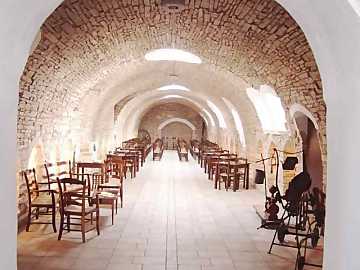 |
| Torrevento's wine tasting hall |
|
In the vineyards located in the Andria area are being cultivated the varieties
Nero di Troia, Aglianico, Bombino Bianco and Pampanuto. In the vineyards of
Torrevento are also cultivated the grapes Cabernet Franc, Cabernet Sauvignon and
Moscato Reale. Besides the wines of Castel del Monte area, Torrevento also makes
other products such as Salice Salentino Rosso, made with Negroamaro and Malvasia
Nera grapes, and purchases Verdeca grapes - cultivated according to organic
agriculture principles - for the production of Puglia Bianco Proemio wine, Nero
di Troia and Montepulciano - still from organic agriculture - for Castel del
Monte Rosso Proemio wine. Torrevento also distributes the wines of I Pàstini
winery - of which is also the productive headquarter - run by Carparelli
brothers. I Pàstini winery owns vineyards for about an acreage of 10 hectares
(about 25 acres) in which are being cultivated Verdeca, Bianco d'Alessano and
Fiano Minutolo grapes used for the production of Locorotondo white wine.
In some rented vineyards, Carparelli brothers cultivate Primitivo grape - with
which is produced the red Primitivo del Tarantino - Cabernet Franc, Cabernet
Sauvignon and Montepulciano used for the red wine Murgia Rosso. The I Pàstini
winery also produces - in limited quantities - the sweet red “Elogio alla
Lentezza” with Aleatico grape. The winery of Carparelli brothers is also
involved since many years to the revaluation of ancient grapes of the area - a
work started with a scrupulous selection and began in 2000 - by searching the
territory in the communes of Locorotondo, Martina Franca, Alberobello and
Cisternino for Fiano Minutolo grape sprouts. These sprouts have been
subsequently grafted in the vineyards of the property in order to resume their
cultivation and in order to make wine. From the result of this selection and of
the revaluation of this particular variety, I Pàstini produces “Vigna
Rampone”, an interesting wine with good personality in which are found intense
aromatic qualities of grape and peach.
Today Torrevento winery is present - besides the Italian market - also in all
the countries of the European Community, United States of America, Canada,
Australia, Hong Kong and Japan. Dr. Francesco Liantonio - chairman of Torrevento
- is in charge for the management, whereas the technical aspects of the winery
are run by wine maker Pasquale Carparelli. The production of Torrevento is wide
and interesting, with wines of good quality in respect of local enological
traditions. Particularly interesting is the last wine created by the winery from
Corato - Kebir - produced with Nero di Troia and Cabernet Sauvignon grapes in
equal parts and aged for 12 months in barrique. Also good is Castel del Monte
Vigna Pedale, agreeable and well made, as well as Moscato di Trani “Dulcis in
Fundo”, pleasing with a balanced sweetness. Among wines produced by I Pàstini
winery are worth of note Fiano Minutolo Vigna Rampone and Locorotondo Bianco.
|


